Case 821F, 921F Wheel Loader Workshop Repair & Service Manual
Catalog:
Model:
Complete digital official workshop repair manual contains service, maintenance, and troubleshooting information for the Case 821F, 921F Wheel Loader. Diagnostic and repair procedures are covered in great detail to repair, maintain, rebuild, refurbish or restore your Case 821F, 921F Wheel Loader like a professional mechanic in local service/repair workshop. This cost-effective quality manual is 100% complete and intact as should be without any missing pages. It is the same factory shop manual used by dealers that guaranteed to be fully functional to save your precious time.
This manual for Case 821F, 921F Wheel Loader is divided into different sections. Each section covers a specific component or system and, in addition to the standard service procedures, includes disassembling, inspecting, and assembling instructions. A table of contents is placed at the beginning of each section. Pages are easily found by category, and each page is expandable for great detail. It is in the cross-platform PDF document format so that it works like a charm on all kinds of devices. You do not need to be skilled with a computer to use the manual.
"84487565.pdf"
821F, 921F Tier 4 Wheel Loader Service Manual
1,063 pages
"84548506.pdf"
821F, 921F Tier 4 Wheel Loader Operator's Manual
340 pages
Part number 84548506
2nd edition English
February 2012
Replaces part number 84324413
EXCERPT:
OPERATION
The refrigerant circuit of the air conditioning system contains five major components: compressor, condenser, receiver-drier, expansion valve and evaporator. These components are connected by tubes and hoses and operate as a closed system.
The air conditioner system is charged with HFC-134a refrigerant.
The compressor receives the refrigerant as a low pressure gas. The compressor then compresses the refrigerant and sends it in the form of a high pressure gas to the condenser. The air flow through the condenser then removes the heat f rom the refrigerant. As the heat is removed the refrigerant changes to a high pressure liquid.
The high pressure refrigerant liquid then flows from the condenser to the receiver-drier. The receiver-drier is a container filled with moisture removing material, which removes any moisture that may have entered the air conditioner system in order to prevent corrosion of the internal components of the air conditioner system.
The refrigerant, still in a high pressure liquid form, then flows from the receiver-drier to the expansion valve. The expansion valve then causes a restriction in flow of refrigerant to the evaporator core. The evaporator meters refrigerant flow based on evaporator heat load.
As the refrigerant flows through the evaporator core, the refrigerant is heated by the air around and flowing through the evaporator fins. The combination of increased heat and decreased pressure causes the air flow through the evaporator fins to become very cool and the liquid refrigerant to become a low pressure gas. The cooled air then passes from the evaporator to the cab for the operator’s comfort.
The electrical circuit of the air conditioning system consists of a fan speed control, temperature control, one (1) relay, a blower motor, blower resistor, A.C. compressor clutch, A.C. low pressure switch, A.C. high pressure switch, and A.C. warning light.
1. EXPANSION VALVE 2. EVAPORATOR 3. COMPRESSOR 4. CONDENSER 5. RECEIVER-DRIER
TROUBLESHOOTING
Perform a visual inspection of the machine. Check the following and correct as necessary:
1. - Obtain service history if possible.
2. - Is compressor drive belt in place and tensioned?
3. - Are grille screens, fan blades, condenser, air filter, and evaporator unobstructed?
4. - Are there any sharp bends or kinks in the hoses?
5. - Are there heavy accumulations of oil, or oily dust around the fittings, indicating refrigerant
leakage?
6. - Are air ducts undamaged, sealed properly and in position?
7. - Condensate drain hoses and check valves present and unobstructed?
Problem: No Cooling
...





